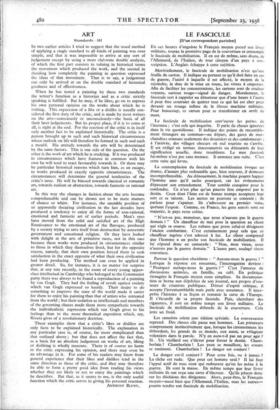ART
Standards—III
IN two earlier articles I tried to suggest that the usual method of applying a single standard to all kinds of painting was over simple, and that it was impossible to arrive at any sort of judgement except by using a more elaborate double analysis, of which the first part consists in valuing in historical terms the movement which produced the work, and the second in deciding how completely the painting in question expressed the ideas of that movement. That is to say, a judgement can only be arrived at on the double standard of historical goodness and of effectiveness.
When he has tested a painting by these two standards the writer's function as a historian and as a critic strictly speaking is fulfilled. But he may, if he likes, go on to express his own personal opinion on the works about which he is writing. This expression of a like or a dislike is usually con- sidered the first duty of the critic, and is made by most writers on the arts—consciously or unconsciously—the basis of all their later judgements. But its proper place, if it is to come at all, is right at the end. For the reaction of the critic is in itself only another fact to be explained historically. The critic is a person brought up in such and such historical circumstances whose outlook on life will therefore be formed in such and such a mould. His attitude towards the arts will be determined by the same factors. This is one side of the question. On the other is the work of art which he is studying. If it was produced in circumstances which have features in common with his own he will tend to react favourably towards it. Or there may be particular historical reasons which turn him, as an escape, to works produced in exactly opposite circumstances. The circumstances will determine the general tendencies of the critic's taste. He will be biassed towards classical or romantic art, towards realism or abstraction, towards fantastic or rational art.
In this way the changes in fashion about the arts become comprehensible and can be shown not to be mere matters of chance or whim. For instance, the unstable position of an apparently decaying civilisation in the last decades have produced a tendency to enjoy all the forms of non-rational, emotional and fantastic art of earlier periods. Men's eyes have moved from the solid and satisfied art of the High Renaissance to the emotional art of the Baroque, produced by a society trying to save itself from destruction by autocratic government and sensational religion. Or they have looked with delight at the arts of primitive races, not in this case because these works were produced in circumstances similar to those in which they themselves lived, but for the opposite reason, namely, that their own position forced them to seek satisfaction in the exact opposite of what their own civilisation had been producing. The method can even be applied in greater detail. So, for instance, it is no matter for surprise that, at any rate recently, in the room of every young upper- class intellectual in Cambridge who belonged to the Communist party there was always to be found a reproduction of a painting by van Gogh. They had the feeling of revolt against society which van Gogh expressed so keenly. Their desire to do something to improve the state of the world made it easier for them to enjoy his painting than that of artists who retreated from the world ; but their isolation as intellectuals and members of the governing classes made them more sympathetic towards the individualistic expression which van Gogh gives to his feelings than to the more theoretical exposition which, say, Rivera gives of a revolutionary doctrine.
These examples show that a critic's likes or dislikes are only facts to be explained historically. The explanation in any particular case is, of course, far more complicated than that outlined above ; but that does not affect the fact that, as a basis for an absolute judgement on works of art, liking or disliking is wholly insecure. There is of course no harm in the critic expressing his opinion, and there may even be an advantage in it. For some of his readers may know from general experience that their likes and dislikes tend in the same direction as those of the critic, and they may therefore be able to form a pretty good idea from reading his views whether they are likely or not to enjoy the paintings which he describes. But that, as it seems to me, is the only useful function which the critic serves in giving his personal reaction.
ANTHONY BLUNT.






































 Previous page
Previous page